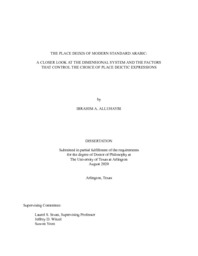
ATTENTION: The works hosted here are being migrated to a new repository that will consolidate resources, improve discoverability, and better show UTA's research impact on the global community. We will update authors as the migration progresses. Please see MavMatrix for more information.
Show simple item record
| dc.contributor.advisor | Stvan, Laurel S | |
| dc.creator | Alluhaybi, Ibrahim A. | |
| dc.date.accessioned | 2020-09-09T20:53:29Z | |
| dc.date.available | 2020-09-09T20:53:29Z | |
| dc.date.created | 2020-08 | |
| dc.date.issued | 2020-08-10 | |
| dc.date.submitted | August 2020 | |
| dc.identifier.uri | http://hdl.handle.net/10106/29356 | |
| dc.description.abstract | This dissertation investigates place deixis in Modern Standard Arabic (MSA) focusing primarily on two issues, 1) examining the dimensional system of place deixis in MSA as opposed to Classical Arabic, and 2) exploring the factors that control the choice of place deictic expressions in MSA: Distance (traditional factor), Visibility, and Contact/Control. While the previous literature focused on one-to-one comparison between Distance and one of the other factors (Imai, 2003; Jarbou, 2010; Peeters, Azar, & Ozyurek, 2014), this dissertation offers a more comprehensive comparison in which all of these factors are compared to each other in different contexts and settings. To address these two issues, a series of three experiments were conducted to examine the hierarchy that is used in the choice of place deictic expressions in MSA. The first experiment aims to shed light on the contradicting reporting of the dimensional system of place deixis of MSA (Fillmore, 1971; Hassan,1973; Kiss & Alexiadou, 2015) by examining the usage of three deictic expressions that were used in Classical Arabic: huna ‘here’ (proximal distance), hunaka ‘there’ (medial distance), and hunalika ‘over there’ (distal distance). The results collected by Qualtrics from 1332 adult native speakers of Arabic native indicate that hunalika ‘over there’ is on the way to being subsumed by the medial deictic expression hunaka ‘there’, and MSA is turning to become a two-dimensional place deictic system. The second experiment investigated the effect of visibility on the choice of place deictic expressions. The results of 1078 subjects suggested that visibility indeed affects the choice of speakers of MSA in two ways: 1) extending the mid-range distance in the eye of interlocutors by making MSA native speakers use more distal deictic expressions such as hunaka (there) instead of hune (here), and 2) avoiding place deictic expressions by reverting to use more descriptive phrases and prepositions. Finally, the third experiment explored the effect of contact/control on the choice of place deictic expressions. The findings of 1104 native speakers of Arabic indicated a significant impact of contact/control on the choice of all three place deictic expressions huna ‘here’, hunaka ‘there’, and hunalika ‘over there’. The participants’ preference changed in all cases after incorporating the contact factor into the use of more proximate locative adverbs such as huna (here). These results, taken together, suggest that the choice of locative adverbs is more complex and affected by multiple elements, and the traditional factor of distance may not be sufficient to understand the process of choice of spatial deictic items in MSA. | |
| dc.format.mimetype | application/pdf | |
| dc.language.iso | en_US | |
| dc.subject | Modern Standard Arabic | |
| dc.subject | Place Deixis | |
| dc.subject | Deictic Expressions | |
| dc.subject | MSA | |
| dc.subject | Classical Arabic | |
| dc.subject | Space Deixis | |
| dc.subject | Visibility | |
| dc.subject | Contact/Control | |
| dc.subject | Distance | |
| dc.title | THE PLACE DEIXIS OF MODERN STANDARD ARABIC: A CLOSER LOOK AT THE DIMENSIONAL SYSTEM AND THE FACTORS THAT CONTROL THE CHOICE OF PLACE DEICTIC EXPRESSIONS | |
| dc.type | Thesis | |
| dc.degree.department | Linguistics | |
| dc.degree.name | Doctor of Philosophy in Linguistics | |
| dc.date.updated | 2020-09-09T20:53:29Z | |
| thesis.degree.department | Linguistics | |
| thesis.degree.grantor | The University of Texas at Arlington | |
| thesis.degree.level | Doctoral | |
| thesis.degree.name | Doctor of Philosophy in Linguistics | |
| dc.type.material | text | |
| dc.creator.orcid | 0000-0003-1459-8915 | |
Files in this item
- Name:
- ALLUHAYBI-DISSERTATION-2020.pdf
- Size:
- 7.702Mb
- Format:
- PDF
This item appears in the following Collection(s)
Show simple item record


